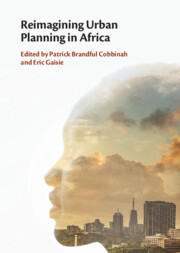Book contents
- Reimagining Urban Planning in Africa
- Reimagining Urban Planning in Africa
- Copyright page
- Contents
- Contributors
- Foreword
- Preface
- Acknowledgements
- Abbreviations
- Part I Understanding Sustainable Urban Planning in Africa
- 1 Reimagining African Cities
- 2 Annals of Urban Planning in Africa
- 3 New Cities in Africa and the Reimagination of Urban Planning
- 4 Informal Settlements and Pro-poor Urban Planning in African Cities
- 5 Urban Planning and Sustainable Land Governance in Africa
- 6 Urban Planning and Climate Change Action in Africa
- Part II Case Studies on Urban Planning in African Countries
- Part III Sustainable Urban Planning in Africa
- Index
- References
3 - New Cities in Africa and the Reimagination of Urban Planning
from Part I - Understanding Sustainable Urban Planning in Africa
Published online by Cambridge University Press: 07 December 2023
- Reimagining Urban Planning in Africa
- Reimagining Urban Planning in Africa
- Copyright page
- Contents
- Contributors
- Foreword
- Preface
- Acknowledgements
- Abbreviations
- Part I Understanding Sustainable Urban Planning in Africa
- 1 Reimagining African Cities
- 2 Annals of Urban Planning in Africa
- 3 New Cities in Africa and the Reimagination of Urban Planning
- 4 Informal Settlements and Pro-poor Urban Planning in African Cities
- 5 Urban Planning and Sustainable Land Governance in Africa
- 6 Urban Planning and Climate Change Action in Africa
- Part II Case Studies on Urban Planning in African Countries
- Part III Sustainable Urban Planning in Africa
- Index
- References
Summary
Rapid and significant spatial transformation is altering the form of major cities in Africa. Slums and informal settlements are being replaced with high-rise buildings and skyscrapers, while luxury residential enclaves, termed ‘new cities’, are being developed on the urban fringe. Yet little is known about the foreign and domestic enablers of new cities, and the implications for reimagining urban planning. Who and what are the roles of foreign and domestic actors involved in development of new cities in Africa? What are the discourses and rationalities guiding the mobilisation and implementation of new cities? And how do new cities underpin or hinder the ‘right to the city’ of African urban residents? This chapter examines the emergence of new cities in Africa by addressing these questions. Using cases from African cities, the chapter argues that the ongoing spatial transformations are linked to broader changes in the global economy such as neo-liberalisation, capital mobility and ambitious city or state governments seeking to create world-class cities. Both domestic and foreign actors are involved in the development of new cities in Africa. These actors are motivated by profit with little or no regard for social inclusion and equity. The chapter argues that the ‘right to the city’ should be an important focal point for new cities and for reimagining urban planning in Africa.
- Type
- Chapter
- Information
- Reimagining Urban Planning in Africa , pp. 36 - 51Publisher: Cambridge University PressPrint publication year: 2023



